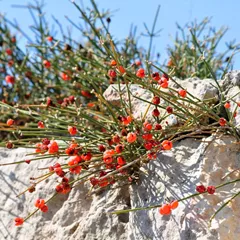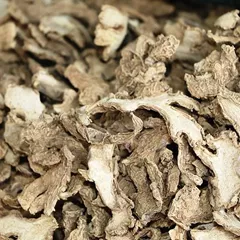Wu Tou Tang
Wu Tou Tang
Chinese: 乌头汤
Pinyin: Wū Tóu Tāng




Wu Tou Tang
Wu Tou Tang
Chinese: 乌头汤
Pinyin: Wū Tóu Tāng
Number of ingredients: 6 herbs
Formula category: Formulas that warm the Meridians and disperse Cold
- Warms the channels and remove obstruaction
- Disperse Cold and Dampness
- Warms the joints
- Relieve joints pain
Source date: 220 AD
Source book: Essentials from the Golden Cabinet
The information provided here is not a replacement for a doctor. You shouldn't use it for the purpose of self-diagnosing or self-medicating but rather so you can have a more informed discussion with a professional TCM practitioner.
Wu Tou Tang is a 6-ingredient Chinese Medicine formula with Prepared Sichuan Aconite (Zhi Chuan Wu) and Ephedra (Ma Huang) as principal ingredients.
Invented in 220 AD, it belongs to the category of formulas that warm the Meridians and disperse Cold. Its main actions are: 1) warms the channels and remove obstruaction and 2) disperse Cold and Dampness.
On this page, after a detailed description of each of the six ingredients in Wu Tou Tang, we review the patterns and conditions that Wu Tou Tang helps treat.
The six ingredients in Wu Tou Tang

Zhi Chuan Wu is a king ingredient in Wu Tou Tang. Like the name indicates, it means it has more power than other ingredients in the formula.
1. Prepared Sichuan Aconite (Zhi Chuan Wu)
Part used: Processed mother root
Nature: Hot
Meridian affinity: SpleenHeartKidneyLiver
Category: Herbs that dispel Wind and Dampness
Zhi Chuan Wu is pungent, bitter and hot. It is a very powerful herb to remove Cold from the channels and release it from the Exterior. It is used to stop joint pain due to Cold obstructed in the joints. Together with Ephedra, they work closely to warms the Interior and fight against external Pernicious Influence.

Ma Huang is a king ingredient in Wu Tou Tang. Like the name indicates, it means it has more power than other ingredients in the formula.
2. Ephedra (Ma Huang)
Ma Huang is warm and slightly bitter. It enters the Lungs and Bladder channels and invigorate Qi there so as to remove Stagnation in the Lungs. It can disperse Wind Cold through the Exterior.

Bai Shao is an assistant ingredient in Wu Tou Tang. This means that it either serves to reinforces the effect of other ingredients or it moderates their toxicity.
3. White Peony Roots (Bai Shao)
Part used: Dried root
Nature: Neutral
Meridian affinity: LiverSpleen
Category: Tonic herbs for Blood Deficiency
In general Bai Shao's main actions are as follows: "Tonifies the Blood and preserves the Yin. Nourishes the Liver and assists in the smooth flow of Qi. Regulates the meridians and eases the pain."
In the context of Wu Tou Tang, it is used because it helps reduce the muscle spasms caused by Blood Deficiency and Stagnation.

Gan Cao is an assistant ingredient in Wu Tou Tang. This means that it either serves to reinforces the effect of other ingredients or it moderates their toxicity.
4. Liquorice (Gan Cao)
Part used: Dried root and rhizome
Nature: Neutral
Taste(s): Sweet
Meridian affinity: HeartLungSpleenStomach
Category: Tonic herbs for Qi Deficiency
In general Gan Cao's main actions are as follows: "Tonifies the Basal Qi and nourishes the Spleen Qi. Clears Heat and dispels toxicity. Moistens the Lungsexpel phlegm and stop coughing. Relieves spasms and alleviates pain. Harmonizes and moderates the effects of other herbs."
In the context of Wu Tou Tang, it is used because it harmonizes the actions of the other herbs, detoxing and eases pain.

Huang Qi is an assistant ingredient in Wu Tou Tang. This means that it either serves to reinforces the effect of other ingredients or it moderates their toxicity.
5. Milkvetch Roots (Huang Qi)
In general Huang Qi's main actions are as follows: "Tonifies the Wei Qi and stops perspiration. Tonifies the Spleen Qi and the Yang Qi of the Earth Element. Tonifies the Qi and Blood. Expels pus and assists in the healing of wounds. Helps to regulate water metabolism in the body and reduce edema."
In the context of Wu Tou Tang, it is used because it strengthens the original Qi by tonifying it. It helps the Ephedra and in releasing the Exterior.

Feng Mi is an envoy ingredient in Wu Tou Tang. This means that it directs the formula towards certain area of the body and/or harmonizes the actions of other ingredients.
6. Honey (Feng Mi)
Part used: Honey
Nature: Neutral
Taste(s): Sweet
Meridian affinity: StomachLarge intestineLung
Category: Laxative herbs that drain downward
In general Feng Mi's main actions are as follows: "Reinforces the spleen and stomach. Moistens dryness, relieves pain, and detoxifies."
In the context of Wu Tou Tang, it is used because it harmonizes all the other herbs of the formula and detoxing.
Conditions and patterns for which Wu Tou Tang may be prescribed

'Cold' as a body pattern in Chinese Medicine is one of the so-called "Eight Principles". Learn more about Cold pattern in Chinese Medicine
Cold invading the Channels joints and muscles
Pulse type(s): Tight (Jin), Floating (Fu)
Symptoms: Joint pain Stiff neck Joint stiff Swollen joints Pain in the muscles Numbness of the muscles
Wu Tou Tang is sometimes prescribed by TCM practitioners to treat Cold invading the Channels joints and muscles. This pattern leads to symptoms such as joint pain, joint stiff, pain in the muscles and swollen joints. Patients with Cold invading the Channels joints and muscles typically exhibit tight (Jin) or floating (Fu) pulses.
It is a type of the Painful Obstruction Syndrome (Bi Syndrome 痹证). The Chinese name is called Tong Bi or Han Bi (痛痹 / 寒痹).
The Defensive Qi can be penetrated by external Pernicious Influences when the patients is in poor health. When the Cold invades the Channels and joints and settles there, it... read more about Cold invading the Channels joints and muscles
Painful Obstruction
Pulse type(s): Tight (Jin), Wiry (Xian)
Symptoms: Knee pain Elbow pain Ankle pain Joint pain Wrist pain Stiff neck Lumbar pain Joint stiff Stiff ankle Stiff wrist Muscle pain Shoulder pain Tenosynovitis Knee stiffness Swollen joints Elbow stiffness Tendonitis wrist Shoulder stiffness Lumbar spine stiffness Numbness in the muscles De quervain's tenosynovitis
Wu Tou Tang is sometimes prescribed by TCM practitioners to treat Painful Obstruction. This pattern leads to symptoms such as lumbar pain, shoulder pain, knee pain and elbow pain. Patients with Painful Obstruction typically exhibit tight (Jin) or wiry (Xian) pulses.
Painful Obstruction Syndrome is also called Bi Symdrome (Bi Zheng). 'Bi' means Stagnation or blockage in Chinese. It occurs mainly due to Exterior Pernicious Factors invasion such as Wind, Cold, Dampness or Heat.
There are four types of Painful Obstruction Syndrome patterns according to the... read more about Painful Obstruction
Formulas similar to Wu Tou Tang
Ge Gen Tang is 43% similar to Wu Tou Tang
Huang Qi Jian Zhong Tang is 43% similar to Wu Tou Tang
Xiao Qing Long Tang is 38% similar to Wu Tou Tang
Xiao Yao San is 33% similar to Wu Tou Tang
Fang Ji Huang Qi Tang is 33% similar to Wu Tou Tang
Gui Zhi Shao Yao Zhi Mu Tang is 33% similar to Wu Tou Tang













